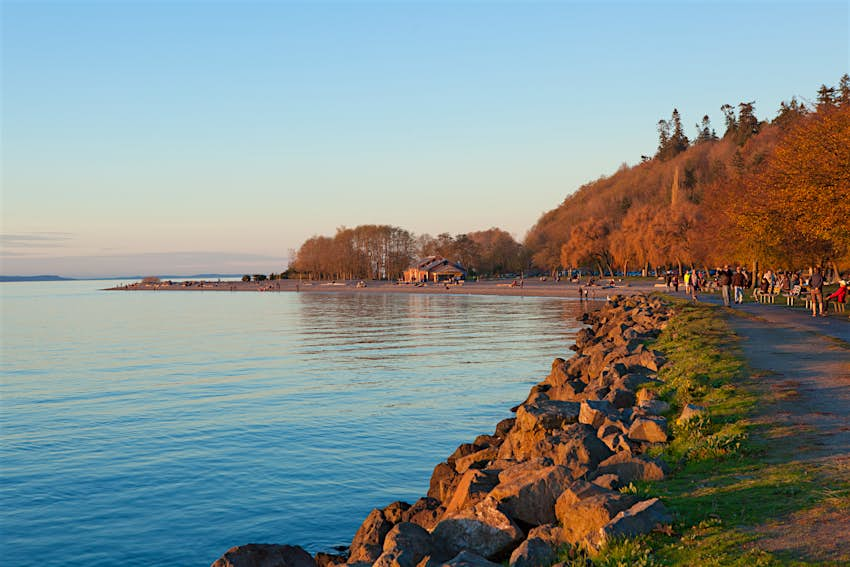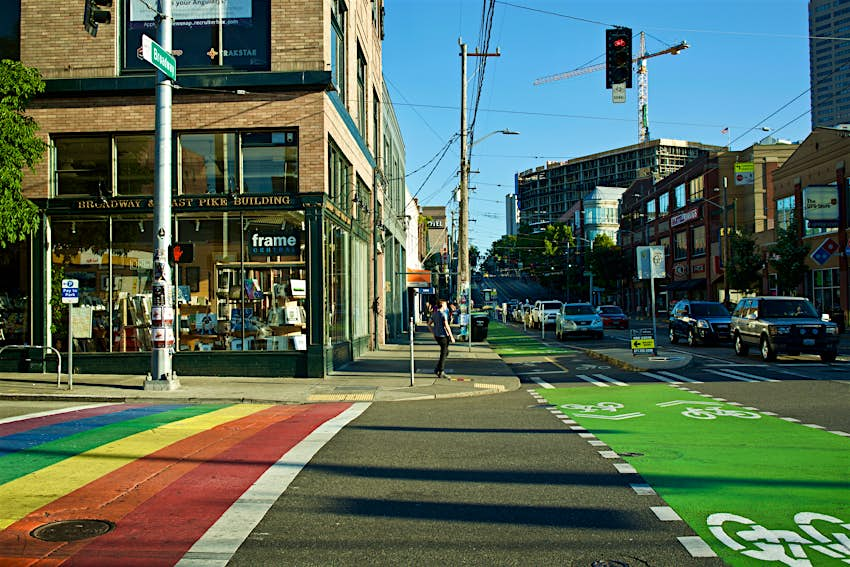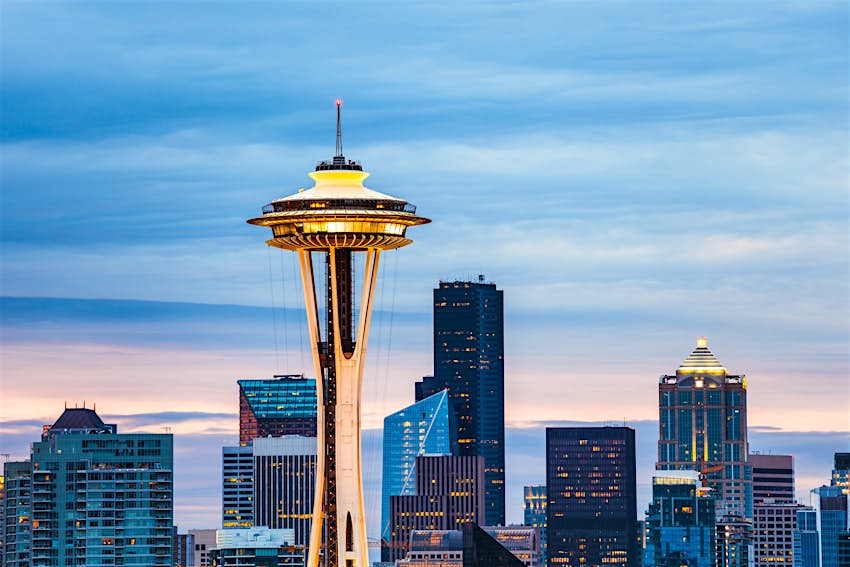Visitors setting out to explore Seattle should think of the city as a United States of Neighborhoods or – to put it in more human terms – a family consisting of affectionate but sometimes errant members.
There’s the aloof, elegant one (Queen Anne), the social butterfly (Capitol Hill), the artistic, bearded one (Fremont), the effortlessly cool one (Ballard), the grizzled old patriarch (Pioneer Square), the precocious adolescent still carving out its identity (South Lake Union) and the one who lives out of town (West Seattle). You’ll never fully understand Seattle until you’ve spent a bit of time with them all. Here’s where to start:

Ballard
A former seafaring community with Nordic heritage, Ballard still feels like a small town engulfed by a bigger city. However, that’s not to say it’s lacking in attractions. The neighborhood has come into its own as one of the city’s best locales for exciting restaurants, lively bars and killer shopping.
The commercial heart of Ballard stretches out on either side of NW Market St between roughly 14th Ave NW and 32nd Ave NW, which is lined with an expanding selection of eateries, shops, and nightlife, though some local faves like pizza joint Delancy and its sibling bar Essex spill outside those lines. You can find everything from American comfort classics to fresh seafood at The Walrus and the Carpenter to Oaxacan cuisine and Lebanese treats at The Golden Beetle.

These blocks closer to the water contain many of the neighborhood’s most charming historic buildings, now home to a bevy of modern offerings, including some of the best shopping in the city. The neighborhood’s far west side is bordered by the Puget Sound and has staggering views of the water and Olympic Peninsula to match.
On the southwestern edge you’ll find the historic Hiram M Chittenden Locks, from where you can continue south over the water to the hiking trails of Discovery Park. Don’t miss the unconnected western section of the recreational Burke-Gilman Trail that stretches from Hiram M Chittenden Locks out to Golden Gardens Park (1.75 miles) and takes in a different, quieter side of Ballard that faces the open Sound.

Capitol Hill
To decipher Seattle’s most diverse, fashionable and consciously cool neighborhood it’s useful to understand a little of its geography. There are three main commercial strips worth exploring in Capitol Hill – Broadway (the main drag), 15th Ave and the ultra-cultural Pike–Pine corridor – all of which are refreshingly walkable (if you don’t mind hills).
Geographically the strips are gelled together by Capitol Hill’s residential grid, a mixture of apartment complexes, large grandiose houses and the green expanse of Volunteer Park. This weird but never caustic juxtaposition of chic and scruffy is one of the neighborhood’s biggest allures.

If you’re walking up from downtown crossing I-5 on E Pine St, you’ll enter the neighborhood close to Melrose Market at the western end of the Pike–Pine corridor. This stretch of aging brick warehouses and former 1950s car dealerships made over into gay bars, live-music clubs, coffeehouses, record stores and fashionable restaurants is Seattle’s nightlife central.
Running perpendicular to Pike–Pine is Capitol Hill’s main commercial street, Broadway, while several blocks east is the quieter business district of 15th Ave E. This is where some of the city’s wealthiest residents live in the grand old mansions that embellish tree-lined streets such as 14th Ave (aka Millionaires Row). Gawp at the opulence as you make your way up to Capitol Hill’s peak, Volunteer Park, home to the Seattle Asian Art Museum, a conservatory and a water tower.
More genteel First Hill is best accessed from the bottom of Pike–Pine or by the streetcar line that bears the neighborhood’s name.

Fremont
Weirder than Ballard and more self-deprecating than Capitol Hill, Fremont’s essential business is its public sculpture. Most of its outlandish statues and monuments lie clustered around a few square blocks on the southern edge of the neighborhood close to the bridge, roughly between the water and NW 36th Street, stretching to Aurora Avenue North and Phinney Avenue North. Here you’ll also find the bulk of the notable eating places, offbeat boutiques and Fremont’s best situated hotel.
Fremont’s a great neighborhood for getting a taste for local life, especially in summer, when festivals and regular outdoor movies send the locals positively delirious. With good bus connections and a bike-friendly intra-urban trail, it can easily be incorporated with visits to the adjacent neighborhoods of Ballard and Wallingford.

Belltown and Seattle Center
Where industry once roared, glassy condos now rise in the thin, walkable strip that is Belltown. The neighborhood gained a reputation for trend-setting nightlife (read: grunge) in the 1990s, but these days it’s more renowned for its 100-plus restaurants.
Capitol Hillers might disagree, but Belltown’s main nightlife zone (1st and 2nd Avenues between Blanchard and Battery Streets) is the best place in the city to string together a bar-hopping evening out. A few of the grunge-era landmarks are still in business, but these days distorted guitars compete with the chatter of the cocktail crowd. Whatever your fashion affiliations, Belltown’s after-dark scene is hip and noisy and rarely stands still.

Belltown is also near the Seattle Center, home of the Space Needle, Museum of Pop Culture, Chihuly Garden and Glass, and former site of the legendary 1962 World’s Fair. Today the green lawns and fountains attract, in equal measure, gawking tourists and families looking for a retreat from the bustle of downtown.
Entertainment-wise, the Seattle Center offers plenty of sit-down plays, concerts and films. The McCaw Hall is home of the Seattle Opera and the Pacific Northwest Ballet, plus there’s a cinema, a children’s theater and a regional theater in the complex. It’s also a fun place to just hang out, especially in summer when alfresco events and street performers take over.

Pioneer Square, International District, and SoDo
Browsing the Pioneer Square Historical District is rather like visiting a movie set of early 20th-century Seattle, except that the food and the shopping are better. This is the birthplace of Seattle, and the red-brick district of historical buildings, antique shops and musty bars is still a real crossroads of the modern city.
Some visitors arrive by long-distance bus or train at King Street Station, a good place to get oriented due to its proximity to a trio of local squares. A few blocks west of the station is Pioneer Square Park, an architectural showpiece, and neighboring Occidental Park was recently given a beautiful face-lift. Just off Occidental Square, Zeitgeist will brew your first (and possibly best) Seattle coffee. Take time to wander the streets afterward to admire the handsome architecture.

To the east of King Street Station is the International District (ID) – Seattle’s de-facto Chinatown. The “international” moniker has some merit: while predominantly Chinese, there is a strong Vietnamese presence and a few reminders of the city’s Japantown, which has never recaptured its pre-WWII vibrancy after its citizens were detained in internment camps during the war.
Access spread-out SoDo by strolling south on 1st Avenue South. Beyond its two sports stadiums you’ll stumble upon rugged bars, weed dispensaries, a whiskey distillery and a little-known computer museum.

Queen Anne and Lake Union
At some point during your Seattle sightseeing sojourn, you’ll want to exit the tourist-heavy Seattle Center and be deposited on one of the busy thoroughfares of Lower Queen Anne, a lived-in urban locale good for a cheap meal or an eye-widening dose of Seattle coffee culture. To get a view of a posher side of the neighborhood, take a steep hike (or jump on a bus) up Queen Anne Ave N, aka “the Counterbalance” to a markedly different neck of the woods.

Georgetown and West Seattle
Located south of downtown and its industrial extension, SoDo, the neighborhoods of Georgetown and West Seattle feel detached from the center by the glassy expanse of Elliott Bay and SoDo’s utilitarian warehouses. Since transportation connections to downtown are better than those between the neighborhoods, they’re often visited separately. Georgetown can be incorporated with a visit to the Museum of Flight, while West Seattle works as a summer-weekend beach getaway courtesy of sandy Alki Beach.
Spread over a hilly peninsula, the neighborhood spins on two hubs: the de-facto downtown called “the Junction” at the intersection of California Ave SW and SW Alaska St (whose indie record store, one-in-a-million bakery and smattering of great restaurants make worth the visit), and the aforementioned famous beach and its promenade. Free shuttles from the water-taxi dock connect with both.

The U District
Head east off I-5 north of Lake Union and suddenly you’ll feel as if you’re no longer in Seattle. The U District, named for “U Dub” (what locals call the University of Washington, or UW), feels like its own little college town. Just like you, most of the people here are visitors – they’re merely staying a bit longer (several semesters or more).
Nearly everyone gets oriented in the U District on “the Ave” (University Way, roughly between 40th and 50th Sts), an atmospheric main drag full of tiny cheap eateries, thrift stores, record stores, secondhand bookstores, tattoo parlors, bars, and coffee shops full of deadline-chasing, laptop-gazing students. Read fly-posters on lampposts, eavesdrop on conversations in coffee bars and follow the action on the Ave and you’ll soon feel 23 again (if you aren’t already).
The number of cheap places to eat, especially Indian and southeast Asian cuisines, makes the Ave the best place to find an inexpensive meal. If you want to head inside, lose yourself in the cavernous University Book Store, which takes up an entire city block.
Reserve a sunny day to explore the adjacent UW campus, a veritable arboretum/architectural showcase with a couple of top-notch museums focusing on art and natural history. The campus is made for people-watching (or, more specifically, student-watching) and you can enter many of the buildings unannounced, including the Suzzallo Library and the Hub (student union).







